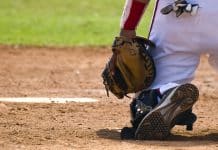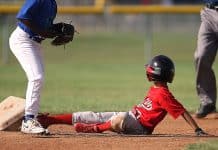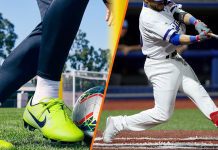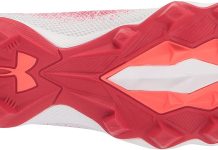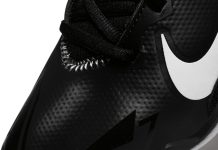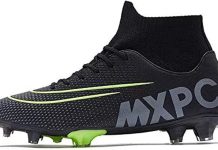When it comes to finding the perfect pair of baseball cleats, deciding which features are the most important can be overwhelming.
Should you prioritize traction or comfort? Are metal spikes better than rubber?
Fear not, as we guide you through choosing the ideal baseball cleats to enhance your performance on the field and keep you comfortable throughout the game.
From durable construction to proper fit and grip, we’ll help you navigate the world of baseball cleats and find the right pair to elevate your game. When choosing the right baseball cleats, several factors come into play.
With so many options available on the market, it can be overwhelming to know which features are most important.
Fear not, as we have compiled a comprehensive guide to help you make an informed decision and find the perfect pair of baseball cleats that cater to your needs and preferences.
Fit
Review contents
Correct size
The first and most crucial factor to consider when purchasing baseball cleats is ensuring you get the correct size. Ill-fitting cleats can cause discomfort and may even lead to injuries.
Measuring your feet accurately and referring to the shoe manufacturer’s size chart is essential to finding the perfect fit. Remember that baseball cleats should have a snug but not overly tight fit, allowing for some wiggle room for your toes.
Width options
In addition to the correct size, consider the width options for the cleats you want. Some manufacturers offer different width options, such as regular, narrow, and wide, to accommodate various foot widths. Choosing the correct width ensures optimal comfort and prevents unnecessary pressure on your feet.
Ankle support
Another crucial aspect of fit is ankle support. Depending on your preference and playing style, you may opt for cleats with different levels of ankle support. Low-top cleats provide minimal ankle support but offer greater mobility, while high-top cleats offer maximum ankle support but may somewhat restrict movement. Mid-top cleats strike a balance between the two, providing moderate ankle support without sacrificing too much mobility.
Cleat Type
Molded cleats
Molded cleats, also known as stud cleats, are a popular choice among baseball players. These cleats feature rubber or plastic studs permanently attached to the outsole. Molded cleats offer excellent traction on most playing surfaces and suit various field conditions. They are also more affordable than other cleats, making them a cost-effective option for players of all ages and skill levels.
Metal cleats
Metal cleats are known for their superior traction and durability. These cleats feature metal studs that can be easily replaced when they wear out. Metal cleats provide excellent grip on dirt and grass surfaces, making them ideal for outdoor play. They are particularly favored by professional players and those who need maximum traction for aggressive movements on the field.
Turf cleats
Turf cleats, also known as turf shoes or rubber cleats, are designed specifically for artificial turf surfaces. These cleats feature numerous rubber nubs or small studs across the outsole, providing excellent traction on synthetic turf. Turf cleats are a great option for players who frequently play on artificial surfaces or participate in indoor practices. They offer enhanced stability and prevent damage to the turf, making them a popular choice for players of all levels.
Material
Synthetic materials
Many baseball cleats on the market are made from synthetic materials. Synthetic cleats are lightweight, durable, and often more affordable than other materials. They are engineered to provide excellent breathability, allowing air to circulate and keep your feet cool and dry during intense gameplay. Synthetic cleats are also known for their flexibility, allowing for natural foot movement and greater comfort on the field.
Leather
Leather cleats are considered the gold standard by many baseball players. They offer exceptional durability, longevity, and comfort. Leather cleats conform to the shape of your feet over time, providing a customized fit and reducing the risk of blisters and discomfort. While leather cleats tend to be pricier, they are often worth the investment for players who prioritize quality and long-term performance.
Mesh
Mesh is another popular material used in baseball cleats. Cleats with mesh uppers offer superior breathability, perfect for players who sweat heavily or play in hot weather conditions. Mesh cleats are lightweight, allowing for faster movements and reduced fatigue. These cleats are also known for their flexibility and quick-drying properties, ensuring optimal comfort and performance throughout the game.
Cleat Closure
Lace-up
Lace-up cleats are the traditional choice for many baseball players. They offer a secure and customized fit, allowing you to adjust the tightness according to your preference. Lace-up cleats provide excellent stability and support, preventing slippage and reducing the risk of injuries. They are also easy to adjust during a game if you need to make quick changes.
Velcro
Velcro closures have gained popularity in recent years, especially among younger players. Velcro cleats are convenient and easy to use, making them an excellent option for those who struggle with traditional laces. These cleats offer a secure fit and can be quickly fastened and removed, saving time and effort. Velcro closures are particularly beneficial for players with limited dexterity or those who prefer a hassle-free shoe closure system.
Combination
Some cleats feature a combination of lace-up and Velcro closures. This hybrid design offers the best of both worlds, combining the adjustability and customization of laces with the convenience and ease of Velcro. Cleats with combination closures provide a secure fit, allowing for quick adjustments and easy on-off transitions.
Outsole
High traction
The outsole is a critical component of baseball cleats, as it directly impacts traction on the field.
Look for cleats with an outsole that offers high traction to prevent slipping and provide stability during rapid movements. Studs or nubs on the outsole should be strategically placed to grip the playing surface effectively, whether grass, dirt, turf, or a combination of surfaces.
Durable
Durability is another essential aspect to consider when evaluating the outsole. The outsole should be made from rigid materials that can withstand the rigorous demands of baseball gameplay. It should resist wear and tear, ensuring the cleats remain functional and intact even after multiple seasons of use.
Flexible
While traction and durability are crucial, the outsole should also offer flexibility. Flexibility allows your feet to move naturally, facilitating quick changes in direction and swift movements during gameplay. A flexible outsole enhances your overall performance, making it easier to perform pivots, cuts, and jumps without feeling restricted or uncomfortable.
Midsole
Cushioning
The midsole of baseball cleats plays a vital role in providing comfort and cushioning. Look for cleats with ample cushioning in the midsole to absorb impact and reduce stress on your feet and joints.
Proper cushioning helps prevent injuries such as shin splints and reduces fatigue, allowing you to perform at your best for extended periods. Cushioned midsoles also offer enhanced shock absorption, reducing the strain on your legs during intense gameplay.
Support
Support is essential in a sport that involves frequent running, jumping, and sudden lateral movements. Cleats with a supportive midsole help minimize the risk of injuries and provide stability during these dynamic movements.
Look for cleats that offer good arch support and ankle stability. Proper support ensures a secure fit and can help prevent common foot problems such as plantar fasciitis or ankle sprains.
Shock absorption
Baseball involves repeated impact on hard surfaces, which can take a toll on your feet and legs. Cleats with shock-absorbing midsoles help minimize the strain on your body, reducing the risk of injuries and improving overall comfort.
The shock absorption properties of the midsole should evenly distribute the forces of impact, ensuring that your feet and legs remain protected throughout the game.
Upper
Breathability
Breathability is essential, especially during hot weather or intense gameplay. Cleats with breathable uppers allow air to circulate, keeping your feet cool and dry. Look for cleats with mesh or perforated uppers that promote airflow and wick away moisture. Breathable uppers help prevent discomfort, blisters, and unpleasant odors commonly associated with sweaty feet.
Padded collar
A padded collar adds extra comfort and support around the ankle. Look for cleats with a padded collar, which helps reduce friction and prevents chafing during gameplay.
The padded collar provides added cushioning and support to the ankle, reducing the risk of sprains and injuries. This feature is particularly beneficial for players who prioritize ankle stability or have a history of ankle problems.
Toe protection
Baseball cleats should offer optimal toe protection to minimize the risk of injury. Look for cleats with reinforced toe caps or overlays that provide added durability and protection in the toe area.
This feature is essential for players involved in aggressive base running or sliding, as it helps prevent painful toe injuries and adds longevity to your cleats.
Weight
Lightweight
The weight of your baseball cleats can significantly impact your performance on the field. Lightweight cleats offer several advantages, including increased speed, agility, and reduced fatigue. Look for cleats that prioritize lightweight construction without compromising other crucial features. Lighter cleats allow for faster movements and acceleration, giving you a competitive edge on the field.
Stability
While weight is essential, finding the right balance between weight and stability is also crucial. Cleats that are too lightweight may sacrifice stability and support. Look for cleats that balance weight and stability, providing a secure and stable base during gameplay. Strike the perfect balance between freedom of movement and stability to optimize your performance and reduce the risk of injuries.
Comfort
Comfort should never be compromised when choosing baseball cleats. Look for cleats that prioritize comfort by offering cushioned midsoles, breathable uppers, and a supportive fit. Comfortable cleats allow you to focus on the game without distractions, ensuring you perform at your best for the entire match.
Remember that what works for one person may not work for another, so finding the right combination of comfort and performance is essential.
Ankle Mobility
Low-top cleats
Low-top cleats are the most flexible option when it comes to ankle mobility. These cleats allow for a wide range of motion, providing maximum mobility for rapid movements, pivots, and quick changes in direction. Low-top cleats are excellent if you prioritize agility and flexibility over ankle support.
Mid-top cleats
Mid-top cleats strike a balance between ankle support and mobility. They offer moderate ankle support without limiting movement too much. Mid-top cleats are suitable for players who desire stability and freedom of movement. They are often favored by infielders and outfielders who need support during quick sprints and lateral movements.
High-top cleats
High-top cleats provide the highest level of ankle support among the three options. These cleats extend above the ankle, offering maximum stability and protection. High-top cleats are commonly preferred by pitchers and catchers who require enhanced support during their movements on the field. They are also beneficial for players with a history of ankle injuries or those seeking extra stability.
Budget
Affordable options
Baseball cleats come in a wide range of prices. Consider your budget and look for cleats that offer the best value for your money. Affordable options can still provide excellent performance, durability, and comfort without breaking the bank. Many reputable brands offer reasonably priced cleats that meet the needs of casual players and younger athletes.
Quality vs. cost
While it may be tempting to choose the least expensive option available, it’s essential to consider the quality of the cleats. Investing in a higher-quality pair of cleats can offer long-term benefits, including increased durability and superior performance. Quality cleats are often made from better materials, providing enhanced comfort and functionality.
Long-term investment
Viewing your cleats as a long-term investment is a wise approach. Consider how frequently you play and the wear and tear your cleats will likely endure. Investing in durable, high-quality cleats may cost more upfront but can save you from frequently replacing them. High-quality cleats often offer advanced features and technology that can improve your performance and overall playing experience.
Choosing the right baseball cleats is crucial for optimal performance and injury prevention. You can select cleats that meet your specific needs and preferences by considering factors such as fit, cleat type, material, cleat closure, outsole, midsole, upper, weight, ankle mobility, and budget. Remember to prioritize comfort, stability, and durability when making your decision. Happy playing!








